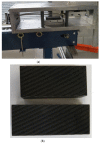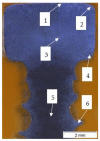Analysis of the New Forming Process of Medical Screws with a Cylindrical Head of 316 LVM Steel
- PMID: 33546329
- PMCID: PMC7913525
- DOI: 10.3390/ma14040710
Analysis of the New Forming Process of Medical Screws with a Cylindrical Head of 316 LVM Steel
Abstract
The originality of this paper lies in the presentation of a new, innovative method for manufacturing medical screws with a cylindrical head of 316 LVM. This method is unique on a global scale, and its assumptions have been granted patent protection. The paper presents selected results of theoretical and experimental research on the developed process of forming of medical screws based on new technology. In the first part of the study a review of the types of screws used in the medical industry is made and the previous methods of their manufacture are described. The second part of the paper presents the assumptions and analysis of the elaborated process of metal forming of medical screws with a cylindrical head and ring thread made of 316 LVM austenitic steel. The theoretical analysis of the new process of forming a screw selected for testing was performed on the basis of numerical simulations. The experimental verification of the proposed theoretical solutions was carried out on the basis of laboratory tests, industrial research and qualitative research. The positive results obtained from computer simulations and experiments confirmed the effectiveness of the developed technology and the validity of its use in future in industrial practice.
Keywords: 316 LVM austenitic steel; computer simulations; industrial research; medical screws; metal forming.
Conflict of interest statement
The authors declare no conflict of interest.
Figures























References
-
- Hanawa T. 1—Overview of Metals and Applications, Metals for Biomedical Devices. 2nd ed. Woodhead Publishing; Cambridge, UK: 2019. pp. 3–29. (Series in Biomaterials).
-
- Basiaga M., Walke W., Antonowicz M., Kajzer W., Szewczenko J., Domanowska A., Michalewicz A., Szindler M., Staszuk M., Czajkowski M. Impact of Surface Treatment on the Functional Properties Stainless Steel for Biomedical Applications. Materials. 2020;3:4767. doi: 10.3390/ma13214767. - DOI - PMC - PubMed
-
- Kajzer A., Niedźwiedź S., Kajzer W., Marciniak J., Gzik-Zroska B., Joszko K., Kaczmarek M., Pilecki Z. Innovations in Biomedical Engineering. Volume 1223. Springer; Berlin/Heidelberg, Germany: 2020. Study of Strength and Fatigue of Stainless Steel and Titanium Plates. AAB 2020. Advances in Intelligent Systems and Computing. - DOI
-
- Rezaei A., Golenji R.B., Alipour F., Hadavi M.M., Mobasherpour I. Hydroxyapatite/hydroxyapatite-magnesium double-layer coatings as potential candidates for surface modification of 316 LVM stainless steel implants. Cer. Inter. 2020;16:25374–25381. doi: 10.1016/j.ceramint.2020.07.005. - DOI
Grants and funding
LinkOut - more resources
Full Text Sources
Other Literature Sources

